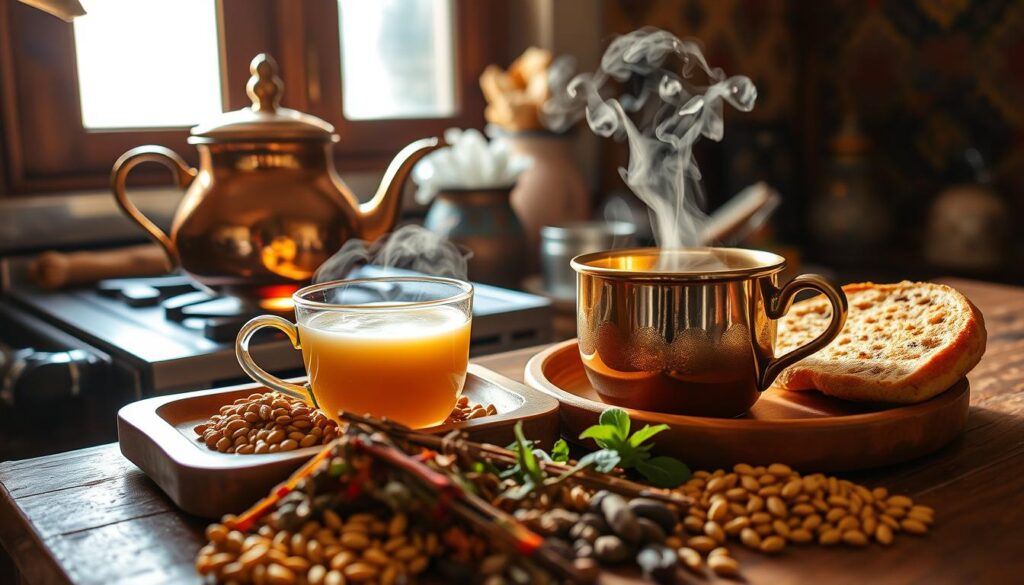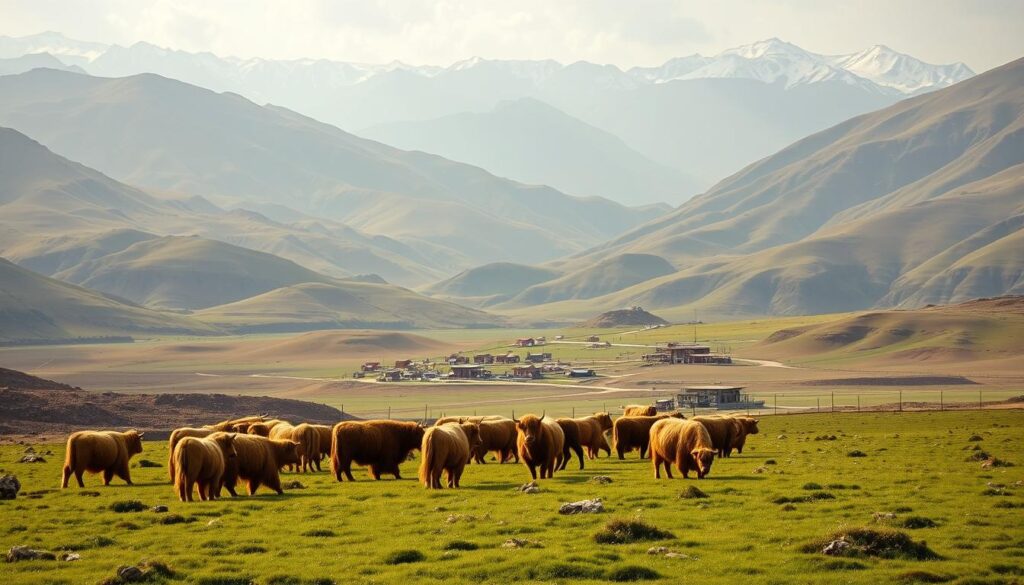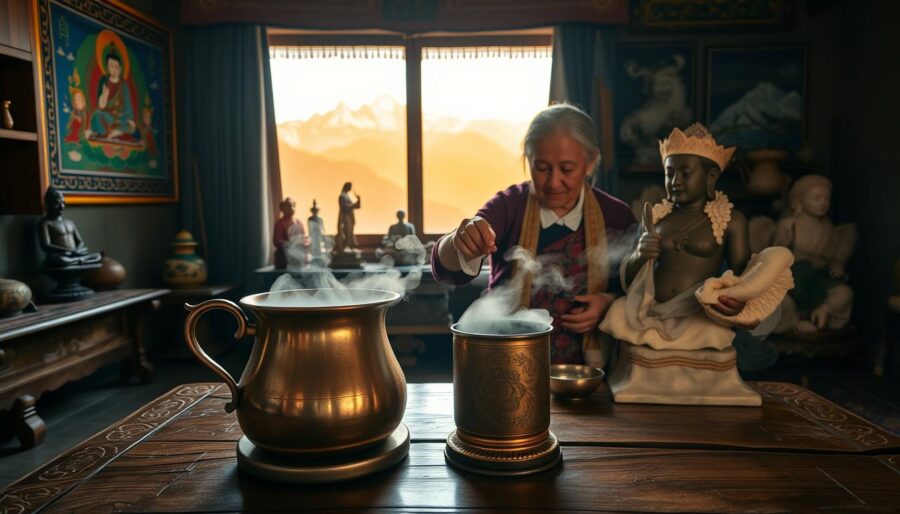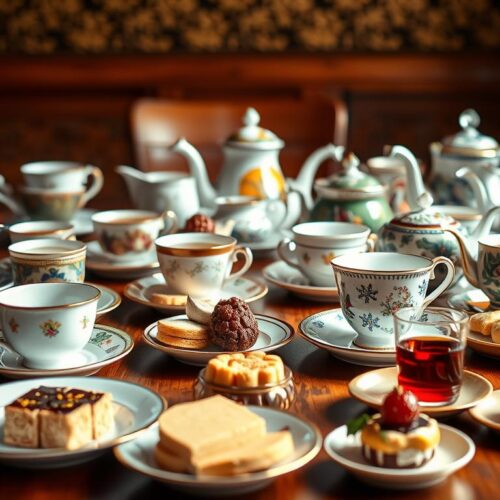Tibetan butter tea, called Po Cha, is more than just a drink in Tibetan culture. Made from black tea, yak butter, and salt, it offers a taste unique to Tibet. It’s not just about good flavor; the tea represents Tibetan hospitality and strength. In cold conditions, Po Cha provides essential nutrition and warmth. It also brings people together, celebrating their shared customs. This drink is fundamental in Tibet, with many benefits to explore.
Introduction to Tibetan Butter Tea
Tibetan butter tea, or Po Cha, adds a rich layer to global tea culture. Unlike the sweet teas many know, it’s savory. It mixes tea, yak butter, and salt into a special flavor. In Tibet, Po Cha is more than a drink; it gives energy, warmth, and brings people together.
Drinking Tibetan butter tea is an immersive experience. It embodies a tradition that welcomes you into Tibetan life. Whether in a local home or a tea house, it connects you with Tibet’s history and people.
Ingredients of Tibetan Butter Tea
Tibetan butter tea is known for its creamy feel. It is made from strong black tea, yak butter, and salt. To start, they use tea from compressed bricks. This tea is boiled for hours to get its strong flavor.
Yak butter makes the tea special. It’s tangier and fattier than normal butter, enriching the tea’s creaminess. Drinking it provides needed calories in cold, high places.
Salt is key in making the tea. It balances the flavors and helps with hydration, especially in the mountains. Together, these ingredients create a nourishing and enjoyable drink. Learning to make butter tea means understanding the importance of each ingredient. This understanding helps make the tea authentic and full of character.
Health Benefits of Tibetan Butter Tea
Tibetan butter tea is very beneficial, especially for those in tough places like the Tibetan Plateau. It’s packed with calories and nutrients, thanks to yak butter. This helps give a big energy boost for daily tasks and fighting tiredness.
The mix of tea, butter, and salt keeps your body’s fluids balanced. In dry climates, this is super important for staying hydrated. The salt in the tea holds onto water, ensuring you’re hydrated all day. Plus, the butter in the tea keeps your skin moist in rough weather, helping you stay healthy.
This traditional drink does more than feed your body; it also fights off altitude sickness. This makes it a must-have for people living there. By drinking it often, it boosts your stamina and endurance. This shows it’s a key part of a healthy diet, especially where life’s a bit harder.

Butter Tea and Hydration
Butter tea plays a big role in Tibetan culture, especially in keeping people hydrated in dry, high places. Even though it’s rich in fats, the salt in the tea helps keep water in the body. This is especially good for those who do a lot of physical work or go trekking.
Butter tea is both energizing and thirst-quenching, making it a must-have in Tibet. It’s great for anyone, local or visitor, to stay hydrated in the dry climate.
Comfort and Warmth: A Psychological Aspect
Tibetan butter tea is more than a drink; it’s part of the culture it comes from. This tea brings warmth and comfort, especially in Tibet’s cold weather. Every sip feels like a warm hug, helping your mind and body feel better.
When you join in Tibetan tea rituals, you feel closer to others. Being with friends and family around butter tea makes everyone feel they belong. This feeling of togetherness boosts how happy and cozy we feel.
By taking part in these rituals, you connect with a tradition about community and happiness. Each cup of tea lets you share in a story of comfort and warmth, during both solo moments and gatherings.
Tibetan Butter Tea as a Meal Replacement
Tibetan butter tea, also known as Po Cha, is a great meal replacement. It’s especially helpful for those doing heavy physical work. The tea is rich in calories from yak butter and tea. It keeps you warm and energized, which is perfect for nomads and workers in the cold.
The ingredients in Tibetan butter tea are full of important nutrients. They help keep your energy up all day. This drink is perfect when you need quick nourishment. It gives you warmth and energy to keep going strong.
| Key Nutritional Aspects | Tibetan Butter Tea | Typical Meal |
|---|---|---|
| Calories | Approximately 500 per serving | Approximately 700-800 per serving |
| Fat | Excellent source (high in healthy fats) | Moderate (varies by meal type) |
| Protein | Low (depends on additional ingredients) | Varies (generally higher) |
| Carbohydrates | Minimal (mainly from tea and butter) | Higher (dependent on the meal) |
For those looking for a meal replacement, Tibetan butter tea is an excellent choice. It’s easy to make and can be taken anywhere. This makes it a great pick for busy lifestyles. It ensures you can get the nutrients you need, whenever you need them.
Preparing Tibetan Butter Tea at Home
Making butter tea at home is easy and fun. It starts with boiling black tea for a strong taste. Next, mix in yak butter and a bit of salt. If you don’t have yak butter, use unsalted butter and whole milk instead.
You don’t need special tools to make this tasty drink. A simple blender or shaker will do the trick. This way, you get a creamy tea that feels like the Himalayas.
- Boil water and steep black tea strongly.
- Add yak or unsalted regular butter with salt.
- Churn it until frothy. You can use a blender or shaker.
Enjoy making and drinking this unique tea at home. It’s a cozy and delightful experience.
Pairing Tibetan Butter Tea with Food
Tibetan butter tea goes well with many foods, making meals better. Tsampa, or roasted barley flour, is a favorite choice. It adds a rich, nutty flavor. Together with butter tea, they make a great combo.
This drink fits many meals, from breakfast to dinner. Try it with momos (dumplings) or thukpa (noodle soup). These dishes let the unique taste of butter tea stand out.
If you’re visiting Tibet, have butter tea with local foods. It makes the flavors and your experience richer. This combo turns mealtime into an adventure. It lets you explore and enjoy Tibetan culture more.
| Food Pairing | Description |
|---|---|
| Tsampa | Roasted barley flour that pairs well with butter tea, enhancing its texture and flavor. |
| Momos | Delicious dumplings filled with meat or vegetables, perfect for complementing the tea’s richness. |
| Thukpa | A hearty noodle soup that offers a savory base that harmonizes with butter tea. |
| Yak Cheese | A traditional cheese that adds a creamy texture, enhancing the overall taste experience. |
The Environmental Impact of Butter Tea Production
Making Tibetan butter tea is closely connected to both culture and the environment. It starts with yak farming to get yak butter. While yaks support traditional lifestyles, they also bring challenges for sustainability and the environment. Their grazing can cause soil erosion and harm local plants in the sensitive Tibetan Plateau.
To keep butter tea production sustainable, it’s crucial to understand yak farming’s impact. Using sustainable methods, like rotating grazing areas and organic feeds, helps protect the ecosystem. It’s important to balance keeping traditions alive with caring for the environment where this special tea comes from.

| Aspect | Positive Impact | Negative Impact |
|---|---|---|
| Yak Farming | Supports traditional livelihoods and preserves cultural heritage. | Can lead to overgrazing and soil degradation. |
| Sustainability Practices | Promotes ecological balance and reduces environmental harm. | Often requires investment and education to be effective. |
| Environmental Impact | Boosts local biodiversity through managed grazing. | Potential loss of native species due to habitat disruption. |
Enjoying Tibetan butter tea means you’re part of a tradition that goes way back. It means considering how yak farming, being sustainable, and the overall impact of making the tea matter. Knowing about these things helps you appreciate this ancient drink more.
Misconceptions About Tibetan Butter Tea
Many misunderstandings exist about Tibetan butter tea. These misconceptions can make us miss what’s special about it. People often think it will be sweet. Instead, its saltiness is what stands out.
There’s also confusion about yak butter. It’s different from the butter we usually know. Yak butter adds a unique taste and feeling to the tea. Understanding these facts helps us truly value this Tibetan tradition.
Conclusion: Embracing Tibetan Butter Tea
Tibetan butter tea lets you dip into the deep traditions of Tibet. It’s not only a drink but also a warm hug from Tibetan culture. It brings people together, making them feel at home in the Himalayas.
Imagine sipping this tea with loved ones or while exploring beautiful mountains. It links you to Tibet’s ancient customs. Every cup tells a story of survival, unity, and pride.
Adding this special tea to your routine is a salute to Tibet’s heritage. It’s more than a drink; it opens a window to a rich culture. So, let Tibetan butter tea be a part of your adventures and celebrate Tibet’s incredible spirit.




